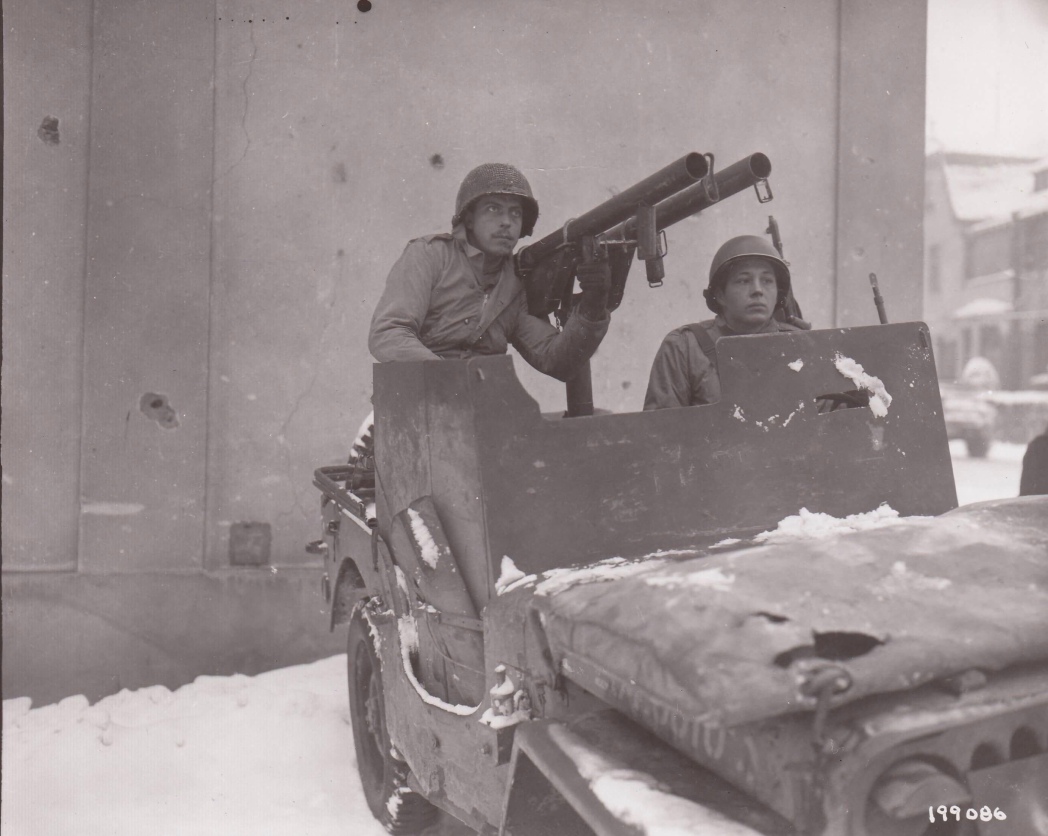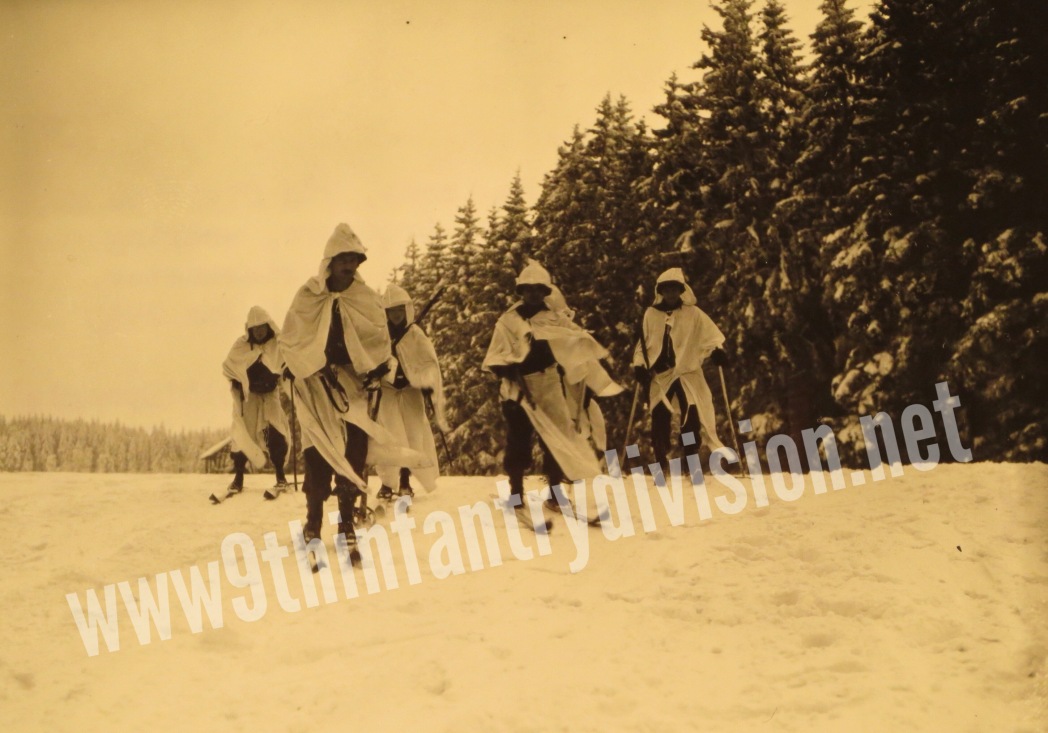– The Ardennes –

60th Infantry Regiment I & R Jeep.60th Infantry Regiment I & R Jeep. On the left T/5 Louis Gorgye and on the right, Pvt William R. Jump – January 12th, 1945.
By mid-December the Allies were preparing to advance to the Rhine. Posed to cross the Ruhr River opposite the city of Duren, the 9th Infantry Division heard reports during the nights between 16th and 18th of December, widely scattered enemy Airborne landings to the south were spotted. On December 16th, low clouds, fog and snow hampered Allied aerial observation. Eight Panzer Divisions hit the weakest sector of the Allied line which was the thinly stretched U.S. VIII Corps. Taking the Allies by surprise, enemy tanks drove over fifty miles, creating a salient 45 miles at its widest, aiming for Liege, Brussels and Antwerp. II Panzer Division was turned back only four miles from the Meuse River by the U.S. 2nd Armored Division on December 25th.
On December 17th, the 47th Infantry Regiment was attached to V Corps. Colonel George W. Smythe moved his troops to the northern shoulder of the Wehrmacht offensive near Monschau. Enroute, he began to pick up bits and pieces of other outfits, including Artillery, tanks, Armored Infantry, Tank Destroyers and reconnaissance units. A Washington Star columnist wrote about this: “Colonel Smythe in few hours organized what was essentially a complete new Division from American units caught and smashed in the breakthrough. Then he used it to stop in its tracks the enemy assault, thus saving the vital communications center of Eupen in Belgium which German General Von Rundstedt had fixed as the convergence point for his assault on Liege and making it possible to retain the communications system already established by the 1st and 3rd Armies in north eastern Belgium and western Germany. Through the winter forest, Colonel Smythe set out in a jeep and soon he ran into roads with American troops and guns retreating into Eupen. The Colonel speedily organized these retreating troops around the center of his own 47th Regiment and was given unqualified command of all the troops in the area. The defence was a tactical masterpiece according to military experts. The enemy paratroopers were mopped up in groups in the forest. Heavy artillery barrages from Colonel Smythe’s hastily organized Division prevented the Germans from re-launching the attack. Thanks to Colonel Smythe, the probable main objective for the enemy attack was defeated”.
While Colonel Smythe pulled together his “Little Division”, the 9th Infantry Division moved into a line fronting the Monschau – Elsenborn sector. German assaults by the though 3rd Panzer Grenadier and 272nd Volksgrenadier Divisions were driven back with a powerful assist from the Artillery. The Stars and Stripes newspaper reported: “Neither rain, nor snow, nor Hitler’s SS can stop the Ninth Infantry Division”. According to the U.S. Army Report of Operations, Von Rundstedt had sacrificed the best part of 4 Divisions in his repeated attempts to assault the Elsenborn Ridge and the Monschau area. Without the Monschau-Eupen and Malmedy-Verviers roads he could not follow out his plan to commit II Panzer Corps, which still remained in reserve on the east flank of I SS Panzer Corps. His hopes of reaching Liege via Verviers were smashed by the fierce resistance of the troops along the northern shoulder of the gap and at St. Vith.
During January 1945, the 9th Infantry Division held a line from the road center north of Konzen to the high ground east of Elsenborn. Supply and evacuation were major problems due to deep snow and freezing temperatures. Service elements of the Division started to make snow plows, felt inner soles and camouflage snow suites. Charcoal was obtained for front-line troops to burn in improvised stoves. The men of the 9th Division held out against blizzards, trench foot, frost-bite and against frequent bursts of German artillery shelling.

Men of 3rd Battalion, 60th Infantry Regiment receive new snow suits for winter warfare camouflage in January 1945 near Mutzenich, Germany.

Men of 3rd Battalion, 60th Infantry Regiment on ski patrol, wearing new snow suits for winter warfare camouflage in January 1945 near Mutzenich, Germany.
Mid-January the Wehrmacht began to withdraw to the east. The Ninth Infantry Division crossed the Ruhr River and in early February, captured the Urftallsperre Dam, the second largest of the river’s massive dams, with the storage of 13000 million gallons of water. Moving on the Division captured the Ordensburg “Vogelsang” training camp for Nazi party leaders at Wollseifen.
From here on the 9th Infantry Division fought their way to the next objective: Crossing the Rhine River in March 1945.
Source: 9th Infantry Division – “Old Reliables” book